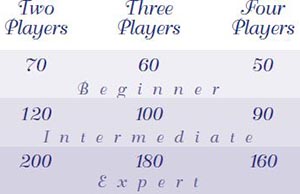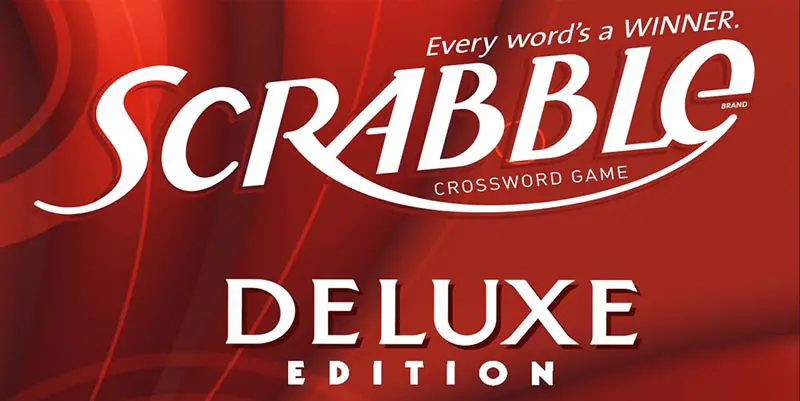
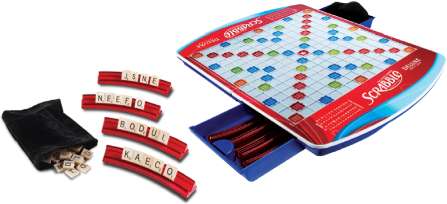
Components
- Game case
- 100 Letter tiles
- Letter pouch
- 4 Racks
Setup
Letters: Place all letter tiles in the pouch, or facedown beside the board, and mix them up. Draw for first play. The player with the letter closest to "A" plays first.
A blank tile beats any letter. Return the letters to the pool and remix. All players draw seven new letters each and place them on their racks.
Scorekeeper: Pick a player to keep score on paper (not included).
Object of the Game
In the SCRABBLE game, players form interlocking words, crossword fashion, on the gameboard using letter tiles of different values. Each player competes for high score by taking advantage of the letter tiles, as well as the premium squares on the board.
In a 2-player game, a good player scores in the 300-400 point range.
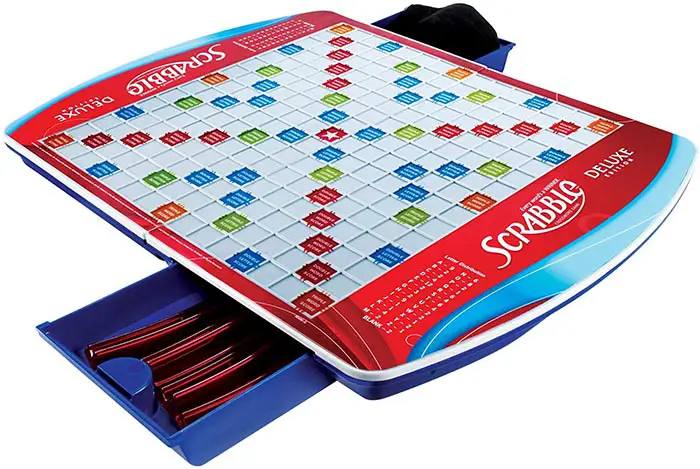
Game Play
Some players like to adapt the standard game rules by suspending some restrictions, or adding others as described in the "variations" below. All players must agree, before the game begins, to allow these changes.
-
The first player combines two or more of his or her letters to form a word and places the word on the board to read either across or down with one letter on the center
 square. Diagonal words are not allowed. Since it uses a "premium square", the score for this first word is doubled.
square. Diagonal words are not allowed. Since it uses a "premium square", the score for this first word is doubled.Variation
A long first word opens the game up faster, so you may set a minimum length of 3, 4 or 5 letters for the first word placed on the board.
If the first player cannot make a word of the agreed-upon length, play passes until a player can do so.
-
Complete your turn by counting and announcing your score for that turn. Then draw as many new letters as you played; always keep seven letters on your rack, as long as there are enough tiles left in the pouch.
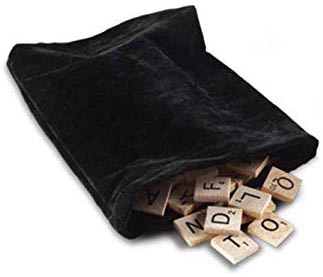
-
Play passes to the left. The second player, and then each in turn, adds one or more letters to those already played to form new words. All letters played on a turn must be placed in one row across or down the board, to form at least one complete word.
If, at the same time, they touch other letters in adjacent rows, those must also form complete words, crossword fashion, with all such letters. The player gets full credit for all words formed or modified on his or her turn.
-
New words may be formed by:
Adding one or more letters to a word or letters already on the board.
Placing a word at right angles to a word already on the board. The new word must use one of the letters already on the board or must add a letter to it.
Placing a complete word parallel to a word already played so the adjacent letters also form complete words.
-
No tile may be shifted or replaced after it has been played and scored.
Variations:
-
You are allowed to rearrange the letters of a word already on the board (as in anagrams) before adding one or more new tiles to it.
The final word (or words) must be acceptable. Premium squares covered by the original word are disregarded in scoring the new or altered words.
-
To "recycle" high-scoring letters during the game: At the start of your turn, you may replace any single letter already on the board with one from your own rack to form an acceptable new word (or words).
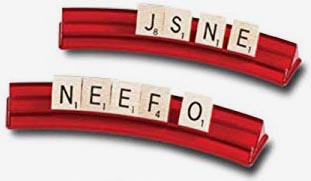
You may do so again on the same turn so long as you replace only one letter at a time and form an acceptable new word.
You do not receive any score for the exchange, but you score in the usual fashion when you add a recycled letter to the board at the end of this or a subsequent turn.
-
-
Blanks
The two blank tiles may be used as any letters. When playing a blank, you must state which letter it represents. It remains that letter for the rest of the game.
Variation
To keep the blanks in circulation: If you have or draw the letter that a blank on the board is representing, you may, on your turn, play your letter tile in the blank's place and take the blank.
You may replace both blanks on the same turn if you have the necessary letter tiles. This exchange does not score any points. Proceed with your regular turn; use the blank(s) now or later.
-
You may use a turn to exchange all or some of your letters. To do this, place your discarded letters) facedown. Draw the same number of letters from the pouch, then mix your discarded letter(s) into the pouch. This ends your turn.
Note: You cannot exchange tiles if there are fewer than seven tiles left to draw.
-
Before the game begins, players should agree which dictionary they will use, in case of a challenge.
All words labeled as a part of speech (including those listed of foreign origin, and as archaic, obsolete, colloquial, slang, etc). are permitted with the exception of the following: words always capitalized, abbreviations, prefixes and suffixes standing alone, words requiring a hyphen or an apostrophe.
The National SCRABBLE* Association recommends the Official Scrabble Players Dictionary Fourth Edition, published by Merriam-Webster for family and school use.
Any play may be challenged before the next player starts a turn. If the play challenged is unacceptable, the challenged player takes back his or her tiles and loses that turn. If the play challenged is acceptable, the challenger loses his or her next turn.
All words (not just one) made in one play are challenged simultaneously. If any word is unacceptable, the entire play is unacceptable. Only one turn is lost on any challenge. Consult the dictionary for challenges only.
Variation
You may waive the limitations on dictionary use. This is especially beneficial to younger players or players interested in vocabulary development.
-
Ending The Game
The game ends when all letters have been drawn and one player uses his or her last letter, or when all possible plays have been made.

Scoring
-
The scorekeeper tallies each player's score, entering it on the scorepad after each turn. The score value of each letter is indicated by a number at the bottom of the tile. The score value of a blank tile is zero.
-
The score for each turn is the sum of the letter values in each word(s) formed or modified on that turn, plus the additional points obtained from placing letters on premium squares.
-
Premium Letter Squares: A blue square doubles the score of a letter placed on it; a green square triples the letter score.
-
Premium Word Squares: The score for an entire word is doubled when one of its letters
is placed on a red square; it is tripled when one of its letters is placed on an orange square. Include premiums for double or triple letter values, if any, before doubling or tripling the word score.
If a word covers two premium word squares, the score is doubled then re-doubled (4 times the letter count), or tripled then re-tripled (9 times the letter count).
Note: The center
 square is red, which doubles the score for the first word.
square is red, which doubles the score for the first word. -
Letter and word premiums count only on the turn in which they are played. On later turns, letters already played on premium squares count at face value.
-
When a blank tile is played on a red or orange square, the value of the word is doubled or tripled, even though the blank itself has no score value.
-
When two or more words are formed in the same play, each is scored. The common letter is counted (with full premium value, if any) for each word.
-
BINGO! If you play seven tiles on a turn, it's a Bingo. You score a premium of 50 points after totaling your score for the turn.
-
Unplayed Letters: When the game ends, each player's score is reduced by the sum of his or her unplayed letters. In addition, if a player has used all of his or her letters, the sum of the other players' unplayed letters is added to that player's score.
What's a Bingo?
A'Bingo is a play that uses all 7 of your tiles, for a 50-point bonus. Bingos are the key to high scores, and they can be easier to find than you might think!
Look for common word beginnings, like UN, DE, RE and OUT. Place them together at the beginning of your rack. Place common word endings like ES, ED, ER, LY, ING, ERS, IER, EST and IES together at the end of your rack.
End of the Game
The player with the highest final score wins the game. In case of a tie, the player with the highest score before deducting or adding unplayed letters wins.
Examples of Word Formation and Scoring
The letters or words added on these five turns are outlined in red. Scores reflect the R being on the center  square.
square.
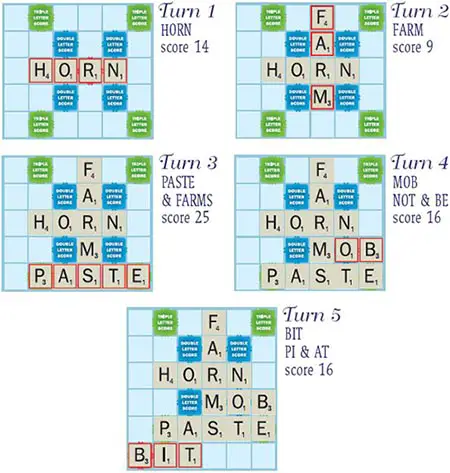
Rules for Shorter Game Play
New Scrabble game players may find these versions faster and more inviting than the standard version.
Variation 1: 9-Tile Scrabble
This variation is identical to the original game except players have 9 tiles on their racks instead of the usual 7. You score a 50-point Bingo bonus for using 7, 8 or all 9 tiles on your rack.
Variation 2: Finish Line Scrabble
In this variant, the game is over when one player reaches a pre-decided score, no matter how many tiles are left.
This variant allows mixed play-level groups, as the score needed to win depends on the level of the player (Beginner, Intermediate or Expert). Below are the points needed to win the game.
If players of the same level are playing, each needs to reach the same score. For example, two Intermediate players would be playing to 120 and four Beginner players would each be playing to 50.
Dos, Don'ts and Things to Remember
-
Play only across the board from left to right, or down-never diagonally or upwards.
-
Do not place letters on the board that result in incomplete or non-existent words.
-
Words must be separated from each other by a vacant square as in crossword puzzles, unless both words together form a complete word.
-
When one player has used all of his or her letters and the pouch is empty, the game ends. No more plays may be made. In some games no player succeeds in using all letters.
In this case, the game continues until all possible plays have been made. A player who is unable to make a play passes that turn, but may make a play on the next turn, if possible.
-
Before the game starts, the players should agree on which dictionary to use. The dictionary should be consulted for challenges only.
A player may neither search for words to fit the letters on his or her rack during the course of the game, nor check the spelling of a word before it is placed on the board.
-
Most standard dictionaries (abridged) contain words that have been assimilated into our language. Therefore, if a word is listed as a part of speech, regardless of its origin, and follows the conditions set forth in Rule 8, it is acceptable.
-
Most standard dictionaries do not show regular plurals or verb endings. A player should check the introduction to the dictionary to see how these inflected forms are handled. Regular plurals and verbs are acceptable, i.e. BOAT, BOATS; TALK, TALKED, TALKING, TALKS.
-
If a player adds an S to a word already on the board, that player receives credit for the entire word.
For example, APPLE is on the board. If a player adds an S to make APPLES, he or she receives credit for the entire word.
-
Once a blank tile has been placed on the board representing a certain letter, the blank cannot be removed nor can the letter it represents be changed during the course of the game.
-
There is no limit to the number of times players may use a certain word during the course of a game. For example, if players wish to use the word IS several times during a game, this is acceptable.

Ten ways to become an Instant Scrabble Expert
There's no doubt about it-it takes a stellar vocabulary and super strategies to become a Scrabble expert. Looking for instant results? These tips from seasoned Scrabble players could help you rule the board!
-
2- and 3-Letter Words
Learn the 2-letter and 3-letter words. They are the building blocks of expert play and can boost your average score by as much as 50 points per game. The list shows the 101 acceptable 2-letter words. If you can master these 2-letter words, they can improve your score:

-
Secret of the "S"
Use an S to form two words at once. Pluralize one word while forming another at the same time. Hint: Use your S wisely. Don't add it unless you can earn at least 8 extra points by doing so.
-
Shuffle Tiles
Shuffle the tiles on your rack frequently. Look for some common ways that letters go together. Some of these are BR, CH, CL, DLE, ED, ENT, EST, FUL, GHT, ING, NK, KLE, MIS, ISM, IUM, MB, MP, ND, NT, PR, PL, RE, STR, TH, UN, IVE, and OUS.
As you form these combinations, it may surprise you how words will often appear when you least expect them.
-
Bonus Squares
Always look for ways to play across premium squares. Check especially for premium squares next to vowels.
-
Consider your Next Play
Make your play with an eye toward your next play. You can do so simply by saving some good tiles on your rack.
Your best odds of having a great next rack is to save some combination of the letters "AEILNRST" (hint: think "starline"), ideally saving either the same number of vowels and consonants, or just one extra consonant.
-
Bingos
Always look for Bingos (using all 7 tiles at once). Optimism and know-how will mean more 50-point bonuses. Learn common word beginnings and endings and know how to place them on your rack.
-
Q without U
Learn the Q-without-U words. The Official SCRABBLE Players Dictionary Fourth Edition lists these: MBAQANGA(S), QABALA()S), QABALAH(S), QADI(S), QAT(S), QAID(S), QI(S)), QOPH(S)), FAQIR(S)), QANAT(S)), TRANQ(S)), QINDAR(S)), QINTAR(S)), QWERTY(S), SHEQEL, QINDARKA, and SHEQALIM.
-
Look for Hooks
"Hooks" are single letters that you can add to existing words that form other words. We've already mentioned the "S hook", but also look for words you could end with a Y, E, R or D. Example: HAND(Y), PLAN(E), TAME(D,R).
-
Choice of Plays
After you find a good play, if you have time, look for a better one. Always try to give yourself a choice of plays. By exercising your decision-making abilities, you'll likely develop keener strategic skills.
-
Attitude
Keep in mind that anyone can beat anyone else with a certain amount of luck. Also remember that everyone draws poor combinations of tiles at times, so when you do, take pleasure in making the best play you can.
Finally, don't dwell on your mistakes. Everyone makes them, so go easy on yourself and just enjoy playing!
Continue Reading
